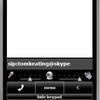Om broke the news about Adobe’s secret VoIP start-up project. I knew about Adobe’s top-secret VoIP plans since June of this year. I interviewed Adobe's <[edit] name withheld per request> back in June and got some interesting insights into Adobe’s plans for adding VoIP to their Flash player and how it could impact social networking sites, such as Myspace.com. Adobe invited me to be an advisor to Adobe due to my experience in the VoIP industry to discuss the architecture and plans for what they are working on – but under NDA. Thus, they asked me to keep quiet about their plans. Now that Om broke the news, I can reveal what Adobe is up to in the VoIP space.
First, I should point out that the Flash player has had VoIP capabilities since March 2002 and the live video capabilities are activated primarily by the existence of a server in the middle called Flash Media Server making it a client-server solution. It uses H.263 codec called Spark made by Sorenson. Many social networking sites and video sites are already using the Flash player, including Myspace.com, YouTube, MSNBC, and many more. Unlike Microsoft Media Player, Macromedia Flash has better cross-platform support, which is why YouTube, MSNBC, and many other sites use Flash. In fact, MSNBC recently switched from only supporting Media Player to now supporting Flash and Media Player, which enabled Windows Firefox users as well as Linux and Mac users to watch videos.
Here are some highlights from my interview with Adobe back in June, which gives some really interesting insights to what Adobe is up to and how this could have a huge impact on the VoIP industry.
Tom: Is it easy to add VoIP to your existing client? Is your code modular?
Adobe: We've done phenomenal engineering to keep the file size small. We've had it for the last 4 years as you know, so our VoIP capabilities need an upgrade. Back in 2002 VoIP wasn't happening as much as it is happening today. So we definitely want to update the Flash player and our other capabilities including Reader and other clients to make sure realtime communications becomes part of suite of products. So our developers can use Flash and other products to build all sorts of interesting things on top.
Tom: With this client would you ever thing about becoming an ITSP (internet telephony service provider)
Adobe: There is no intent to be a phone service provider - rather we just want to be a platform where service providers build all sort of clever applications. As long as the inheritance capabilities on the player and the platform are as good as any softphone and developing a workflow and a graphical interface & services and apps -- which is where hopefully they will make money some day, instead of PSTN replication, which is what the whole industry is doing right now.
Tom: Are you supporting SIP
Adobe: Currently we are only supporting H.263 for video and NellyMoser codec for audio. In the future we’d like to support things like SIP. As you know we’ve brought Dr. Henry Sinnreich, onboard.
Tom: Yup, the grandfather of SIP
Adobe: Henry works on my team and he’s definitely going to be helping us on understanding how SIP applies. So we’re definitely serious about this space which is why we’re putting this rock solid team together.
Tom: You mention the video uses a client-server architecture. Does this mean your future VoIP plans also require a server?
Adobe: You know, frankly I don’t know what value a server will brings long-term in IP communications. That’s the debate we’ve always had – there’s other ways to monetize. Frankly, we’ll never charge for the Flash player, so we have to sell something as a company to make money and feed our engineers. Thus we sold tools, servers, and boxes. Is that the right model moving forward? Who knows? If technically you don’t need a server, why would you push a server down the throat of your customers? We’re not the kind of company that is going to try and make a monopoly out of it. So our customers insist on no server capabilities and essentially just need the client.
Tom: So if it’s just a client, if you go to Myspace.com, how are you handling the negotiating of their username or IP address if there is no central registrar. Are you doing some sort of P2P technology?
Adobe: We’re obviously thinking of that, but I won’t say at this stage we’ve made a decision on that. There is no standards way of doing it unfortunately, which is why you see proprietary implementations that have done a good job and kudos to them for doing that.
Tom: <thinking> (probably a reference to Skype)
<end interview>
Just imagine the impact of this "future" Flash player having VoIP and video capabilities. I can envision a user going to a Myspace blog, seeing who else is “in the room”, and then initiate a 2-way, 3-way, 10-way, etc. audio/video conference using the omnipresent Flash player. All the Myspace user has to do is add a small piece of HTML code to their Myspace blog to enable this and the user has to have the Flash player. Of course, the beauty of the Flash player is that it is a very small client, which is why it is very popular with techies that hate bloatware, and of course the video/audio performance is rock solid. It will be a tricky engineering feat to add a SIP stack, presence information, P2P autodiscovery, and other pieces of code to enable you to have a seamless audio/video conferencing experience simply by visiting a website -- without making the code bloated and turning off users. But if anyone can do it, Adobe can. So keep your eye on Adobe.
Update/Related:
Alec Saunders has some good insights on this as well.
Andy suspects this will be tied into Macromedia Breeze
android apple asterisk at&t blackberry cell phone cisco dell digium e911 facebook fcc google google talk gps im ip-pbx ipad iphone ipod itexpo ITEXPO lync microsoft mobile phone open source outage phone review sip skype sony unified communications verizon video video conferencing voip vonage wireless xbox 360
- Apple (280)
- Bittorrent (2)
- Call Center and CRM (48)
- Computer Hardware (183)
- Computer Software (71)
- Gadgets (650)
- Google (225)
- Home Entertainment (263)
- Internet (173)
- Linux (111)
- Microsoft (376)
- MovableType (48)
- News (187)
- Personal and Humor (118)
- Politics (9)
- Reviews (246)
- Security (2)
- Social Networking (42)
- Sports/Outdoor Technology (9)
- Tablets (32)
- Technology and Science (355)
- Unified Communications (471)
- VoIP (2285)
- Wireless (584)
- p2p (20)
- March 2014
- February 2014
- January 2014
- December 2013
- November 2013
- October 2013
- September 2013
- August 2013
- July 2013
- June 2013
- May 2013
- April 2013
- March 2013
- February 2013
- January 2013
- December 2012
- November 2012
- October 2012
- September 2012
- August 2012
- July 2012
- June 2012
- May 2012
- April 2012
- March 2012
- February 2012
- January 2012
- December 2011
- November 2011
- October 2011
- September 2011
- August 2011
- July 2011
- June 2011
- May 2011
- April 2011
- March 2011
- February 2011
- January 2011
- December 2010
- November 2010
- October 2010
- September 2010
- August 2010
- July 2010
- June 2010
- May 2010
- April 2010
- March 2010
- February 2010
- January 2010
- December 2009
- November 2009
- October 2009
- September 2009
- August 2009
- July 2009
- June 2009
- May 2009
- April 2009
- March 2009
- February 2009
- January 2009
- December 2008
- November 2008
- October 2008
- September 2008
- August 2008
- July 2008
- June 2008
- May 2008
- April 2008
- March 2008
- February 2008
- January 2008
- December 2007
- November 2007
- October 2007
- September 2007
- August 2007
- July 2007
- June 2007
- May 2007
- April 2007
- March 2007
- February 2007
- January 2007
- December 2006
- November 2006
- October 2006
- September 2006
- August 2006
- July 2006
- June 2006
- May 2006
- April 2006
- March 2006
- February 2006
- January 2006
- December 2005
- November 2005
- October 2005
- September 2005
- August 2005
- July 2005
- June 2005
- May 2005
- April 2005
- March 2005
- February 2005
- January 2005
- December 2004
- November 2004
- October 2004
- September 2004
- August 2004
- July 2004
- June 2004
- May 2004
- April 2004
- March 2004
Featured Videos













